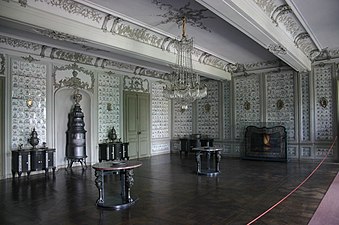The Hohenzollers' margraves ruled large areas of Franconia from the Middle Ages until 1791, their territory stretching, divided into the lines Kulmbach / Bayreuth and Ansbach, from Hofer Land until after Ansbach and Crailsheim. The buildings of the margraves of Brandenburg-Kulmbach shape Bayreuth and the surrounding area to this day. Until 1604 the Plassenburg in Kulmbach was the residence of the princes, then the residence of Margrave Christian von Brandenburg-Bayreuth was moved from Kulmbach to Bayreuth. The Ansbach margraves also left important buildings in Ansbach and Triesdorf, among others.
The eldest daughter of the "soldier king" Friedrich Wilhelm I was originally supposed to become Queen of England. However, through marriage she became Margravine of Brandenburg-Bayreuth. Even today, the locals are proud of theirs Wilhelmine of Prussia and the structures she created.
The names of the margraves changed over the generations and centuries, but their legacy, from the opera house to the hermitage park, which they created between 1398 and 1791, still delight us today. Today the jewelery boxes are cherished and cared for and even declared a World Heritage Site.

In Bayreuth
Margravial Opera House
The 1 Margravial Opera House is considered one of the most beautiful baroque theaters in Europe and is officially announced in 2012 ![]() UNESCO- World Heritage been raised. Commissioned by the Margravine Wilhelmine, it was designed by the Bolognese Giuseppe and Carlo Galli Bibiena.
UNESCO- World Heritage been raised. Commissioned by the Margravine Wilhelmine, it was designed by the Bolognese Giuseppe and Carlo Galli Bibiena.
The opera house is a box theater; the floor without seats can be used for ballets and dance balls. All around are the balconies or tiers, which are divided into individual boxes with partition walls. The interior is made entirely of wood, with a painted canvas. Because of the stucco, carved and painted interior, the opera house is now considered unique in the world, with acoustics like 270 years ago.
- Café at the opera, Opernstrasse 16, 95444 Bayreuth. Tel.: 49 (0)921 5071421. Located in the historic Redoutenhaus, right next to the Margravial Opera House.Open: daily 10 a.m. to 6 p.m., Sundays and public holidays from 12 p.m., closed on Tuesdays.
- Engin's Ponte, Opernstrasse 24-26, 95444 Bayreuth. Tel.: 49 (0)921 8710503. Right on the so-called Grand Canal with outdoor seating and a good view of the opera house.Open: Mon to Sat from 8 a.m. to 2 a.m., on Sundays from 9 a.m.

Main entrance in Opernstrasse
.jpg/148px-Bayreuth_Markgräfliches_Opernhaus_Fürstenloge_(1995).jpg)
The royal box

The stage
New lock
The 1 New lock was built between 1753 and 1758 on behalf of Margrave Friedrich von Brandenburg-Bayreuth as a new city residence after the old castle was largely destroyed by a fire.
The opening times are daily from April to September 9 a.m. to 6 p.m., and from October to March 10 a.m. to 4 p.m., closed on: 1.1., Shrove Tuesday, 24.12., 25.12., 31.12. There are no regular tours. The admission price is € 5.50, combined ticket, three Bayreuth objects of the Bavarian Palace Administration of your choice are € 12.00. Parking is possible in the parking lot P6 of the town hall (Jean-Paul-Straße).
- Bayreuth faience - Rummel collection, Ludwigstrasse 25b. Tel.: 49 (0)921 7596921. The museum is located in the castle. The collection shows the products of the Bayreuth manufactory, founded in 1716, from the beginnings to the end of the heyday in 1788. Faience is ceramics made by hand. Special features include pieces such as coffee pots that are coated with coffee-brown glaze and painted with silver or gold.Open: April to September daily 9 a.m. - 6 p.m., and from October to March 10 a.m. - 4 p.m., closed on: 1.1., Shrove Tuesday, 24.12., 25.12., 31.12. There are no regular tours.
- Museum "The Bayreuth of Margravine Wilhelmine", Ludwigstrasse 25. Tel.: 49 (0)921 7596921. The museum is located in the castle. The chronology of the margrave's time, the history of the Hohenzollerns in Franconia and Bayreuth are illustrated. Originals of drawings, miniatures, prints and books are shown, as well as architectural drawings in the classical style and exhibition boards for the parks.Open: April to September daily 9 a.m. - 6 p.m., and from October to March 10 a.m. - 4 p.m., closed on: 1.1., Shrove Tuesday, 24.12., 25.12., 31.12. There are no regular tours.
- Archaeological Museum, Ludwigstrasse 25b. Tel.: 49 (0)921 65307. The museum of the Historical Association for Upper Franconia is located in the Italian building on parts of the first and second floors. It is the only special museum for prehistoric and early historical finds in Upper Franconia. Finds from the Paleolithic to the Middle Ages are shown. Highlights are stone axes from the Neolithic Age or a replica of a stone drill.Open: late April - early November: Saturday 10 a.m. - 3 p.m. and every first Sunday of the month from 10 a.m. - 12 noon, otherwise guided tours by appointment.Price: Admission: € 1 / € 0.50.
- On the ground floor of the south wing there is one of three rooms Branch gallery the Bavarian State Painting Collections housed. 80 works of Dutch and German painting from the late 17th and 18th centuries are shown. One room is dedicated to the Munich court painter Peter Jakob Horemans.
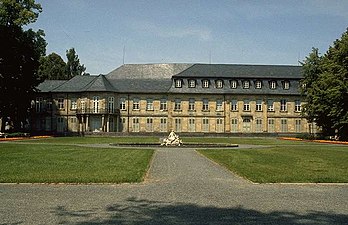
Front view of the New Castle

Finds from the 18th to 19th centuries

Example from the State Gallery - Jan Frans van Bredael- funfair fun: ring piercing
Courtyard garden
The 2 Courtyard garden forms the extension of the New Palace, with a large number of sculptures.
With its paths, water and lawns, the park invites you to stroll and linger. The usual rules for parks apply, entering the lawns, making a fire, etc. is not permitted. There are marked sunbathing areas at the eastern end of Cosima-Wagner-Straße, which is a long way from the New Palace.
The Villa Wahnfried and the Freemason Museum are on the edge of the courtyard garden.
Parking is possible in the parking lot P6 of the town hall (Jean-Paul-Straße), with direct access to the courtyard garden.

Courtyard garden in autumn

The Swan Island with the sculptures Thetis and Tritons
Hermitage
The 3 Hermitage is a historic park and retreat of Margrave Georg Wilhelm (early 18th century) in the St. Johannis district. Parking spaces are available at the entrance to the park.
- The orangery
- The temple of the sun with the quadriga
- The old castle can only be visited as part of a guided tour.
- In the New Palace of the Hermitage (not to be confused with the one already listed above New lock there is a café and the museum ticket office with museum shop in the east wing. The west wing is used for art exhibitions in summer.
- The ruin theater was built by Joseph Saint Pierre as a Roman theater between 1743 and 1745.
The west wing of the New Palace and the central building of the Sun Temple can be rented for private parties from May 1st to September 30th.
The temple of the sun
The quadriga on the temple of the sun
The ruin theater
- Bayreuth studio stage. semi-professional in-house productions. There are several performances in the ruin theater every summer.
- It is a beautiful and romantic festival Midsummer Night Festival at the Hermitage, which takes place in late July / early August every year.
- Hermitage Palace Restaurant, Hermitage 6, 95448 Bayreuth. Tel.: 49 (0)921 799970. Castle restaurant, castle beer garden, café, orangery and quiet hotel rooms.
- Hermit Court, Eremitenhofstr. 34, 95448 Bayreuth. Tel.: 49 (0)921 92131. Almost 200 year old inn next to the Hermitage with Franconian cuisine and beer garden.Open: daily from 10.30 am, with a non-stop kitchen, Thursdays are closed.
- Hermit hermitage, Eremitenhofstr. 29, 95448 Bayreuth. Tel.: 49 (0)921 16276245. Open: Tuesday to Saturday from 2 p.m., Sunday from 11.30 a.m. Franconian lunch menu.
Birken Castle baroque garden

The 4 Birken Castle is a baroque palace complex in the Birken district of Bayreuth. The baroque garden and the tea house of the margravial ministerial house built under Margrave Christian Ernst between 1687 and 1692 have been restored and restored to their original form. After its current owner, the castle is also "Rothen books-Villa "called.
Birken Castle baroque garden, Birken palace courtyard 27. Tel.: 49 (0)921 61878. Open: April to October 15 from Monday to Friday from 9 a.m. to 5 p.m., from October 16 to March there is a winter break.Price: Admission is free.
- Delicatessen Schmauß, Heinrich-von-Kleist-Str. 36, 95447 Bayreuth. Tel.: 49 (0)921 67081, Email: [email protected]. Fine fish smokehouse, game meat, cheese and much more, just 100 meters from the castle. Open: Fri from 9 a.m. to 7 p.m.
Carolinenruhe Castle
5 The place Colmdorf (Königsallee, B 22 towards Weiden) is a district of Bayreuth. It was first mentioned in 1386. The outstanding building is Colmdorf Castle, it is also called Carolinenruhe Castle. You can find them a few hundred meters out of town Jean Paul-Stube in the Rollwenzelei.
In 1662 Margrave Christian Ernst gave the palace to his wife Erdmuthe Sophie as a gift. In 1754 it was acquired by the margrave minister Freiherr von Reitzenstein, who had it rebuilt in its current form in 1754/55 by the court building inspector Rudolf Heinrich Richter. A few years later, Margrave Friedrich bought it back and gave it to his second wife, Sophie Caroline Marie von Braunschweig-Wolfenbüttel, after whom it was then named Carolinenruhe. The castle changed hands frequently until it was bought by the gardener Johann Friedrich Popp in 1886, whose descendants still own the castle to this day.
Colmdorf Castle is a five-axis building with two three-axis side wings. It faces a large garden. A balcony with a wrought iron railing and the initials of Sophie Caroline is attached to the main wing. The gardener's cottage on Königsallee was used as a simple apartment until a few years ago. The decay was stopped by emergency safety measures.
Carolinenruhe Castle
Driveway and main building
St. Georgen am See
St. Georgen is now a district of Bayreuth. Originally, the place was laid out under Margrave Georg Wilhelm in 1702 as an independent city according to plan and in a strictly symmetrical baroque style. Even today you can still find many traces from that time.
- The 6 Order castle St. Georgen, the 7 Princess house and the margraves' breeding and workhouse are now used as a penal institution.
- The water of the river Warm Steinach was diverted to an artificially dammed lake directly behind the castle, the Brandenburger Weyher. It served as the setting for staged naval battles. The lake was drained again in 1775. Today the industrial area is located there. However, you can still find the historical one today Sailor Alley with the former seaman's houses.
Order castle St. Georgen
The sailor alley
Thiergarten hunting lodge

8 The area in Thiergarten had been used by the Margraves of Brandenburg-Bayreuth for hunting for a long time when Margrave Christian Ernst had their first hunting lodge built there. His successor, Margrave Georg Wilhelm, had Johann David Räntz replace the castle with a more solid building. This building is now used as a school.
- Landgasthaus Thiergarten, Oberthiergärtner Str. 15, 95448 Bayreuth. Tel.: 49 9201 9178585. The country inn is in a former domain chamber (provincial authority, used to lease and sell the margraves' possessions). The stables and the farm with its hunting and pheasant garden were built in 1715. Today's restaurant in the restored alluvial stone vault is located in the former cowshed. German and Italian cuisine is offered.Open: Wed to Sat 5:00 p.m. - 10:00 p.m., Sunday and public holidays 11.30 a.m. - 8:00 p.m., closed days are Monday and Tuesday, including public holidays.
In Kulmbach
Plassenburg
- The 9 Plassenburg is the landmark of Kulmbach. Until 1604 it was the seat of the Margraves of Brandenburg-Kulmbach. The current building dates from the years 1557 to 1570. Open daily: April - September 9:00 am to 6:00 pm, October to March 10:00 am to 4:00 pm. The tin figure museum is particularly impressive with over 300,000 tin figures, most of which are exhibited in more than 220 dioramas. Open-air concerts take place regularly in the beautiful courtyard. Special exhibitions are often shown in museums.
The access to the Plassenburg is closed during the day, only access to the disabled parking spaces is possible. You can park in the barracks courtyard from 6 p.m. to 7 a.m. During the day, the Plassenburg is on foot over a steep climb or with the Shuttle bus (Entry at the central parking lot) accessible. Parking is possible in the central car park with a parking ticket or in the underground car park below, or in the underground car park of the town halls next to the central car park. The first hour of parking is free in the underground car park.
- Burgschänke Plassenburg, Festungsberg 26, 95326 Kulmbach. Tel.: 49 (0)9221 81313. Open: Burgschänke: Summer months: Mon to Sun from 11 a.m. to 6 p.m. and from November to March by reservation. The café in the Schönen Hof is open daily from 10 a.m. to 6 p.m. in summer and on Saturdays and Sundays from 10 a.m. to 6 p.m. in winter.
Langheimer Amtshof and Plassenburg

Inner courtyard of the Plassenburg with relief images of the Hohenzollern family
Princess house
10 The princess house in the Upper City. It was built in 1722 by Margrave Georg Wilhelm for the disgraced unmarried Princess Christiane Sophie of Bayreuth. The princess had to live in exile at the foot of the Plassenburg because she had not led an impeccable life. She fell in love under her estate and gave birth to illegitimate twins at the Hermitage, but both children died in childbirth. Today the building is used by the AWO.
Princess house upstairs
Princess house below
In Mistelgau
.JPG/250px-Obernsees_Barockgarten_(2).JPG)
Baroque garden in Obernsees
- The 11 From the time of the margraves there is a garden above the rectory with a 200 year old pavilion, Tel. 49 (0) 9206/992375. At that time the rectory was used by the Margrave from Bayreuth and the Baron von Aufseß during the hunt.
- Aufseẞ'scher Gutshof Mengersdorf, Mengersdorf 26, 95490 Mistelgau. Tel.: 49 (0)9206 993880. With Franconian cuisine based on the seasons. In a more than 400 year old manor, not far from the baroque garden.Open: Tue to Fri 12pm - 2pm and 5pm - 10pm; Sat, Sun and public holidays from 11.30 a.m. to 10 p.m., closed on Mondays.
In Mistelbach
_-_Jagdtisch_des_Markgrafen_von_Bayreuth_im_Waldgebiet_Arzloch.JPG/200px-Mistelbach_(Oberfranken)_-_Jagdtisch_des_Markgrafen_von_Bayreuth_im_Waldgebiet_Arzloch.JPG)
Margraves' hunting table
12 The hunting table of the margraves is a sandstone rock with the hewn hunting table, it is located about 650 m from the center of Mistelbach on the Esbach in the rocky gorge of the Arzloch. There is a carved inscription to be read HUNTING TABLE of the Margraves of Bayreuth, Coord: N 49 ° 55.090 E 011 ° 30.585
In Eckersdorf
Fantaisie palace and park with garden art museum
13 The Fantaisie Castle was built from 1761 to 1763 as another summer residence for the margrave couple Friedrich and Wilhelmine of Brandenburg-Bayreuth. Today it is home to the first German garden art museum. The exhibits and short films depict the history of garden art. The replica of the famous inlaid cabinet by the Spindler brothers is also worth seeing.
- Garden art museum, Bamberger Strasse 3, 95488 Eckersdorf / Donndorf. Tel.: 49(0)921 73140011. Open: April to September from 9 a.m. to 6 p.m., from October 1 to October 15 from 10 a.m. to 4 p.m., closed on Mondays, from October 16 to March there is a winter break.Price: € 3.00 regular, € 2.50 reduced.
- Hotel fantasy, Bamberger Strasse 5, 95488 Eckersdorf. Tel.: 49(0)921 31845. In 1846 the hotel was built by Duke Alexander von Württemberg. Richard Wagner lived in the hotel from April to August 1872 until he settled in Bayreuth. There is still original furniture from that time.Price: single room from 50 €, double room from 80 €.
- Cafe and restaurant fantasy, Bamberger Strasse 5, 95488 Eckersdorf. Tel.: 49(0)921 31845. In the hotel, with banquet rooms and a park terrace.
Fantaisie Palace north facade (main entrance)

Fantaisie Palace south facade
Carpet bed
.jpg/300px-Eckersdorf-Donndorf_-_Schloss_Fantaisie_(Brunnenskulptur_Knabe_mit_Schwan).jpg)
Boy with swan
Fantaisie, goddess of peace
Cascade in the castle park
Neustädtlein Castle in the forest
14 The lock in Neustädtlein you can hardly recognize it as such today. It was built under Margrave Georg Wilhelm and was probably used as an upscale farm. The building later fell into bourgeois hands and suffered from poor maintenance.
The margraves' forester was founded in 1750. The building made of sandstone blocks, half-timbered elements and a slate roof now houses an inn.
- 1 Waldhütte Neustädtlein. Tel.: 49(0)9271 629. The excursion restaurant with beer garden is located in the middle of the forest and can only be reached via unpaved roads.Open: 11 a.m. to 10 p.m., closed on Mondays.
In Hague (Upper Franconia)
Sophienberg
15 The name of the Hague's local mountain, the 595 m high Sophienberg is derived from the wife of the Bayreuth Margrave Christian Ernst, Erdmuthe Sophie was a daughter of Elector George III. of Saxony. Between 1663 and 1668 the margrave let his wife have a castle on the summit, the so-called Sophienburg, to build. Allegedly, she often withdrew to the Sophienburg to enjoy the solitude, which she quickly got tired of. In 1687 she dissolved the household and let the castle fall into disrepair. Another renaming on the occasion of the visit by King Friedrich Wilhelm III. of Prussia and his wife Queen Luise on June 6, 1805 in Luisenberg could not prevail.
In Wonsees
Sanspareil rock garden with oriental architecture
- The 16 Sanspareil rock garden is a landscape garden with bizarre rock formations, ruin theater and the oriental building. The garden was created at the instigation of the Margravine Wilhelmine, a sister of the Prussian King Friedrich II. The rock garden is freely accessible, the museum in the oriental building and the castle café in the kitchen building are open from April to October. The name is said to go back to the exclamation of a guest "C'est sans pareil" - "This is beyond compare". Sanspareil is pronounced decidedly non-French by the locals, if you pronounce it as it is written and replace the "p" with a "b", you will be understood everywhere.

- The medieval 17 Zwernitz Castle. next to the landscaped garden is newly renovated and now includes a hunting museum.Open: April to September from 9 a.m. to 6 p.m., from October 1 to 15, 10 a.m. to 4 p.m., closed on Mondays.
- The Bayreuth studio stage organizes several performances in the ruin theater in Sanspareil at the beginning of August. The spectators sit on chairs, beer benches and beer tables under a rock. The performance takes place without electricity, musicians sit in the orchestra pit with unamplified instruments, the lighting consists of kerosene lamps, torches and candles. As a spectator, you shouldn't forget a flashlight for the way home through the park. Advance ticket sales at the box office in Bayreuth Travel Agency, Luitpoldplatz 9, Tel. 49 (0) 921/69001, Email: [email protected], Monday to Friday 9 a.m. - 6 p.m., Saturday 9 a.m. - 2 p.m.
Zwernitz Castle
The medieval castle Zwernitz was first mentioned in 1156 as the ancestral seat of the Walpoten. Around 1300 it became the official seat of the burgraves of Nuremberg and later the margraves. In the 17th century it lost its military function and Margrave Georg Friedrich Karl had it repaired. Margravine Wilhelmine discovered Zwernitz Castle and the Felsenhain as a gem in the middle of the 18th century, so that the castle was repaired again in this context.

Today the castle houses the permanent exhibition Margravial Hunt, with exhibits and information on the long-gone world of courtly hunting.
- 2 Country inn Weith, Grossenhül 32, 96197 Wonsees. Tel.: 49 (0)9274 467. Franconian cuisine, homemade cakes and gateaux on weekends.Open: daily from noon, closed on Tuesdays.
In Bad Berneck
Hunting lodge Falkenhaube
The 18 Hunting lodge Falkenhaube lies between Himmelkron and Bad Berneck in Bad Berneck-Falkenhaus. The castle was built between 1719 and 1722 by Margrave Georg Wilhelm von Brandenburg-Bayreuth and was used for heron picking with hunting birds. The building has a faint resemblance to a hawk's hood and was not designed for long stays, and is therefore relatively simple in construction.
- Country restaurant Kreutzer Hans, Neudorf 6, 95460 Bad Berneck. Tel.: 49 (0)9273 305. Refreshments nearby.
In Sky crown
monastery
19 Himmelkron Monastery, Klosterberg 8. The Himmelkron Monastery was a Cistercian monastery from the 13th to the 16th century. After that, the Bayreuthers used it Margraves as a summer residence and hunting lodge. Today it serves as a dormitory and day care center for people with intellectual disabilities. Margrave Christian Ernst had a castle built onto the old monastery wing in Himmelkron in 1699, especially for his son, Hereditary Prince Georg Wilhelm. The architect was Antonio della Porta. Margrave Georg Wilhelm had the baroque Red Eagle Hall built, which is now used by the community for weddings and concerts.
View from the White Main to the collegiate church

The monastery from the south
Monastery garden
- The medieval one Herb garden. at the former Cistercian monastery can be visited at any time in daylight in the grounds of the Himmelkroner homes.
Baille-Maille-Lindenallee
- 20 The first Baille-Maille-Lindenallee was laid out between 1662 and 1663. It served the game Paille-Maille, in German piston or barrel game, which the Margraves gladly operated. The Himmelkroner Allee was famous in its time, it was considered the longest and most beautiful in Europe. In 1792 it was cut down under Prussian rule in order to reorganize the state budget. From 1986 to 1992 linden trees were planted again. Events such as festivals and exhibitions take place on the avenue on a regular basis.
Art in the avenue
Baille-Maille-Lindenallee
Atonement Cross

The legend of the White Woman (w: White woman # Plassenburg) on the Plassenburg says the following: Castle mistress Kunigunde von Orlamünde, widow of Count Otto von Weimar-Orlamünde, had fallen in love with Albrecht the Beautiful, son of the Nuremberg burgrave Friedrich IV. He let it be known that he would lead her to the altar if four eyes weren't in the way of the connection. By that he meant his parents, who did not want such a marriage. However, Kunigunde misunderstood the message and related it to her two children, a two-year-old girl and a three-year-old boy. So she stabbed her children in the head with a needle and killed them. As a penance imposed by the Pope for her deed, the murderess should slip on her knees from the Plassenburg to Himmelkron in the monastery. The lady of the castle, however, was on a hill between Trebgast and Himmelkron when she saw the monastery and died of exhaustion. Today it is often said that, according to this legend, an atonement cross was erected at the place of death of Kunigunde. The white woman should be on 21 Atonement cross, appear now and then in the Himmelkron monastery or on the Plassenburg. Next to the atonement cross there is a small stone bench that invites you to rest under a large tree.
In Market people

Kaiserhammer hunting lodge
22 Kaiserhammer is located in the administrative district Wunsiedel in the Fichtel Mountains. Since the regional reform, one district of Kaiserhammer has been a district of Marktleuthen, the other part of the market Thierstein.
In the years 1756 and 1757 it was built under the direction of the young architect Carl Gontard on the instructions of Margrave Friedrich a large, three-winged palace building. It was completed by the court plasterer in the winter of 1759/60 Rudolf Albini finished. However, the hunting lodge only flourished for a short time, the successor Friedrich Christian was already not interested in parforce hunt, and the slow decline began. Margrave Alexander then ordered the buildings to be sold in 1770. After no buyer could be found for the actual castle building, the main wing was demolished in 1792. Of the former buildings, only the kitchen wing and the stable wing are left today.
Rondell Forest
23 In the Leuthenforst district of Marktleuthen, the focus is on the Rondell forest, a hunting garden belonging to the hunting lodge with spider web-like aisles and a former hunting pavilion, where a large linden tree stands today.
In the middle of the large hunting star, a hunting pavilion was built in 1761 and a salon was built on the Tannenberg in 1762, which was not completed due to the death of Margrave Friedrich in 1763. The remains of the salon are known as the Schlößlein ruins.
University City gain

Friedrich Alexander University
In 1742, Margrave Friedrich founded a university for his residence town of Bayreuth, which was moved to Erlangen as early as 1743. Its more than 23,000 students and numerous institutes shape the city today.
Margravial castle
The 24 Margravial castle was built between 1700 and 1704. Together with the palace garden and the orangery behind the palace, it is considered to be the first coherent baroque complex in Franconia. After the castle burned down almost completely in 1814, it was rebuilt for the Friedrich-Alexander University by 1825. Today, the building in the middle of the pedestrian zone is the seat of the university administration, after it also housed the university library in the meantime. The orangery was extensively restored until 2012. The castle park invites you to take a walk and its numerous benches to take a break; during the day you can also access the university's botanical garden from the castle park.
Horseradish cultivation in Baiersdorf
Margrave Johann the Alchemist had horseradish planted in Baiersdorf for the first time in the 15th century, thereby establishing the cultivation in Middle and Upper Franconia.
- 25 Horseradish Museum, Judengasse 11, 91083 Baiersdorf. Tel.: 49 (0)9133 603040. Open: Sat and Sun from 10.30 a.m. to 5 p.m.Price: The entrance fee for adults is € 2.00, children up to 14 years free.
In Ansbach
Margravial residence
- 26 The Margravial residence arose from a late medieval complex and was redesigned in the Rococo style by Gabriel di Gabrieli and Karl Friedrich von Zocha in the 18th century. It houses the Ansbach faience and porcelain collection and a picture gallery. The opening times are from April to September from 9 a.m. to 6 p.m. and October to March from 10 a.m. to 4 p.m. Admission for adults is 4.00 euros.

The main facade of the residence
The tiled hall
The margravine's audience room
- 27 The Orangery The residence in the Hofgarten was built from 1726 to 1728 by Carl Friedrich von Zocha based on French models. It is open all year round, admission is free, there are no restrictions for the disabled.
- Orangery restaurant. Tel.: (0)981 2170.
- Ansbach Palace and Garden Administration, Promenade 27; 91522 Ansbach (Directions by bus: "Schlossplatz" stop). Tel.: (0)981 9538 39-0.
- The Ansbach Rococo Festival revive the time of Margrave Carl Wilhelm Friedrich with courtly hustle and bustle in front of the imposing backdrop of the orangery in the courtyard garden. They take place every year in midsummer in front of the orangery and in the courtyard garden.

The courtyard garden
The orangery
- The Markgrafenweg for cyclists is 20 km long and leads from Ansbach via Bruckberg to the Biberttalweg.
In Weidenbach

The former summer residence of the margraves in Triesdorf, a district of Weidenbach, District Ansbach Today is the seat of the Agricultural Education Center Triesdorf. This makes Triesdorf the smallest place in Germany with a university.
Summer residence Triesdorf
28 On September 18, 1600, Margrave Georg Friedrich I bought the Triesdorf castle estate from Wolf Balthasar von Seckendorff. In the following two centuries the margraves built a princely residence in the style of the time and gave Triesdorf an unusual appearance for a Franconian village.
In Roth

- 29 Ratibor Castle was built by Margrave in 1535–1538 George the Pious of Brandenburg-Ansbach built.
Itineraries

- The Markgrafenweg Markgrafenweg is an approx. 80 km long long-distance hiking trail from Erlangen to Kulmbach, marked by the blue cross marking with the following route:
gain - Adlitz - Honings - Hetzles - Regensberg - Rangen - Kasberg - Graefenberg - Buchwald - Egloffstein - Mostviel - Schlehenmühle - Wichsenstein - Heidekreuz - Gößweinstein - Beringersmühle - Oberailsfeld - Church maple - Christanz - Freiahorn - Altenhimmel - Gubitzmoos - Pittersdorf - Mistelbach – Bayreuth - Kulmbach
The margraves of Kulmbach / Bayreuth
| Johann III. | 1398 | 1420 | Johann resided at the Plassenburg in Kulmbach. | |
| Friedrich I. | 1420 | 1440 | Brother of Johann III, he was Margrave of Ansbach from 1398 and Burgrave of Nuremberg until 1427. From 1412 he was the elector of Brandenburg | |
| Johann the Alchemist | 1440 | 1457 | He was into alchemy and became a disappointment to his father. In favor of his younger brother Albrecht Achilles, Johann renounced his rights through the firstborn. For this he received the Franconian possessions of the Hohenzollern and his residence became the Plassenburg in Kulmbach. | |
| Albrecht Achilles | 1457 | 1486 | Nach seinem Tod erfolgte die von ihm verfügte Landesteilung unter seinen Söhnen in Ansbach und Kulmbach, die seit dem getrennte Markgrafschaften waren, auch wenn sie später teilweise in Personalunion regiert wurden. | |
| Siegmund | 1486 | 1495 | ||
| Friedrich II. | 1495 | 1515 | Friedrich II. wurde wegen seines verschwenderischen Lebensstils abgesetzt und 13 Jahre lang auf der Plassenburg gefangen gehalten. | |
| Kasimir | 1515 | 1527 | ||
| Georg der Fromme | 1527 | 1541 | Erbaute Schloss Ratibor in Roth. War Markgraf von Ansbach und regierte Kulmbach vormundschaftlich bis zur Volljährigkeit seines Neffen Albrecht. Führte die Reformation in beiden Markgrafschaften durch. | |
| Albrecht II. Alcibiades | 1527 | 1557 | ||
| Georg Friedrich I. | 1557 | 1603 | ||
| Christian | 1603 | 1655 | Als neue Residenzstadt wählte er Bayreuth. | |
| Christian Ernst | 1655 | 1712 | Von ihm wurde das barocke Schloss Birken erbaut. | |
| Georg Wilhelm | 1712 | 1726 | St. Georgen am See an. Die Jagdschlösser Kaiserhammer und Jagdschloss Thiergarten, die Eremitage und das Schloss Neustädtlein wurden ebenfalls von ihm erbaut. | |
| Georg Friedrich Karl | 1726 | 1735 | Er baute das ehemalige Himmelkron zum Schloss um. | |
| w:Georg Friedrich Karl (Brandenburg-Bayreuth) | 1735 | 1763 | Mit seiner Frau, der Markgräfin Wilhelmine von Preußen (1709–1758) führte er den Bau des Neuen Stadtschlosses in Bayreuth des Markgräfliches Opernhaus und der Eremitage aus. Friederike Sophie Wilhelmine von Preußen (* 3. Juli 1709 in Potsdam; † 14. Oktober 1758 in Bayreuth) (w:Wilhelmine von Preußen ((1709–1758)) war die Tochter des Königs Friedrich Wilhelm I. und dessen Gattin Sophie Dorothea und wurde durch Heirat mit Friedrich III. von Brandenburg-Bayreuth (w:Friedrich III. (Brandenburg-Bayreuth)) die spätere Markgräfin von Brandenburg-Bayreuth. | |
| Friedrich Christian | 1763 | 1769 | Er reduzierte den Hofstaat und lebte zurückgezogen. | |
| Karl Alexander | 1769 | 1791 | Er verkaufte die beiden Fürstentümer Bayreuth und Ansbach an Preußen, begab sich als Privatmann nach England und widmete sich der Pferdezucht. Im Dezember 1791 kaufte er sich ein Anwesen bei Hammersmith an der Themse, 1798 erwarb er Gut Benham, und am 5. Januar 1806 starb er. |
literature
- Der Roman Die Markgräfin von Sabine Weigand spielt auf der Plassenburg und gibt Einblicke in das Leben einer Adeligen zu Beginn der Neuzeit. Verlag: Krüger, Frankfurt; Auflage: 2 (März 2004) ISBN 3810523658 , ISBN 978-3810523655 .
- ; Rabenstein, Christoph (Ed.): Die Schlösser des Markgrafen Georg Wilhelm von Brandenburg-Bayreuth Bauherr - Künstler - Schlossanlagen - Divertissements. Rabenstein, Ch, 1992, ISBN 978-3-928683-05-0 .
- ; Bayerische Verwaltung der staatlichen Schlösser, Gärten und Seen (Ed.): Lustgärten um Bayreuth Eremitage - Sanspareil - Fantaisie. Hildesheim.Zürich.New York: Georg Olms Verlag, 1998, ISBN 3-487-08401-5 , S. 336 (deutsch).
- Der Tourismusführer Markgrafenkirchen entdecken - Region Bayreuth-Kulmbach ist über die Touristeninformationen Bayreuth und Kulmbach zu beziehen oder auch in vielen Rathäusern und Pfarrämtern der Region erhältlich. In dem Faltblatt werden 50 Markgrafenkirchen auf einer Karte dargestellt und 24 Kirchen mit Bild ausführlich beschrieben.
Web links
- markgrafenkultur.de - Informationen zu historischen Gebäuden, Gärten und Zeugnissen aus der Markgrafenzeit des 18. Jahrhunderts




.jpg/148px-Bayreuth_Markgräfliches_Opernhaus_Fürstenloge_(1995).jpg)









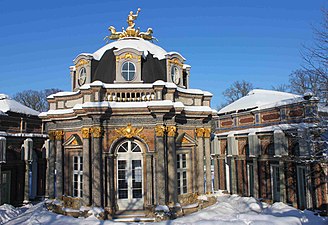
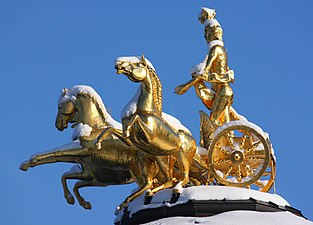


.JPG/350px-Carolinenruhe_(1).JPG)
.JPG/667px-Carolinenruhe_(1).JPG)
.JPG/338px-Carolinenruhe_(2).JPG)



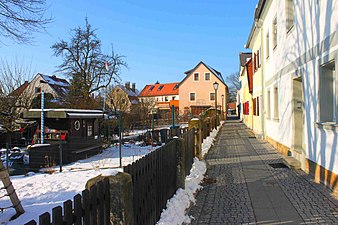




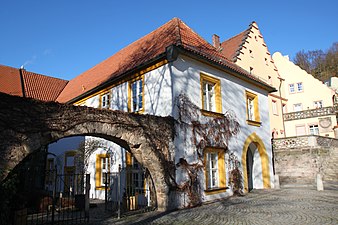

_-_Jagdtisch_des_Markgrafen_von_Bayreuth_im_Waldgebiet_Arzloch.JPG/320px-Mistelbach_(Oberfranken)_-_Jagdtisch_des_Markgrafen_von_Bayreuth_im_Waldgebiet_Arzloch.JPG)




.jpg/300px-Eckersdorf-Donndorf_-_Schloss_Fantaisie_(Brunnenskulptur_Knabe_mit_Schwan).jpg)




















